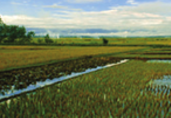Philippines Agriculture
Articles & Analysis | The road to self-sufficiency: Upgrades to irrigation infrastructure will bolster food security from The Report: The Philippines 2012
When typhoons Pedring and Quiel hit the Banaue Rice Terraces in Batad, Ifugao – a UNESCO World Heritage Site – in September 2011, its ancient irrigation infrastructure was severely affected, causing damage to crops, livestock and infrastructure estimated at P872m ($19.8m). The prominence of these natural disasters reignited calls for upgrades to...
Articles & Analysis | Ready for expansion: Initiatives support industry modernisation and promote exports from The Report: The Philippines 2012
Providing employment for nearly one-third of the country’s 39m-strong workforce and central to supporting domestic food security, agriculture and fisheries is of vital importance to the Philippine economy. The government is well aware of the need for stability and steady growth. Current strategic priorities aim to expand planted crop area, increase...
Interviews & Viewpoints | OBG talks to Proceso Alcala, Secretary, Department of Agriculture from The Report: The Philippines 2012
How would you rate the state of agricultural infrastructure in the country? What areas are most in need of investment moving forward?
Articles & Analysis | A mixed basket: Tropical fruits continue to be a profitable export industry from The Report: The Philippines 2012
With its hot weather, abundant rainfall, fertile soil and substantial tracts of arable land, the Philippines is a prime agricultural area for growing a variety of tropical fruits. While already a major global producer of banana, pineapple and mango, the country is looking to boost its exports of these crops still further.
Interviews & Viewpoints | OBG talks to Rica Davila, Chairman and CEO, Lapanday Foods Corporation from The Report: The Philippines 2012
What are the most important recent initiatives that have helped modernise the agriculture sector?


